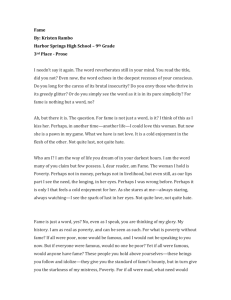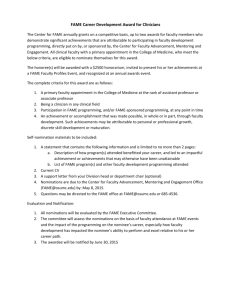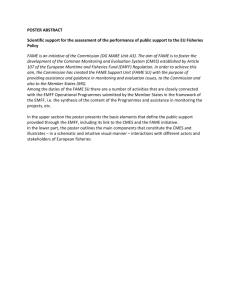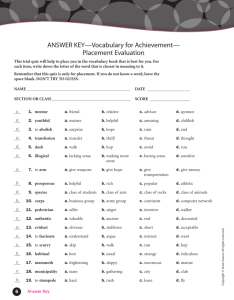IMPACT OF GENDER AND TIME ON FALSE FAME Do Gender and
advertisement
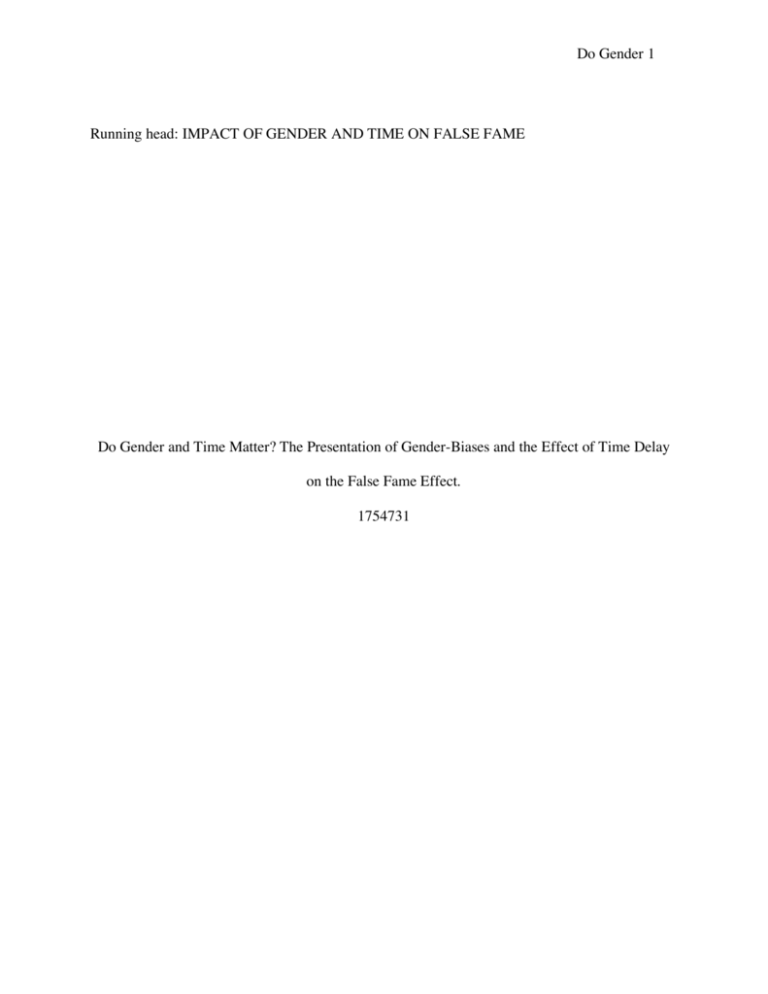
Do Gender 1 Running head: IMPACT OF GENDER AND TIME ON FALSE FAME Do Gender and Time Matter? The Presentation of Gender-Biases and the Effect of Time Delay on the False Fame Effect. 1754731 Do Gender 2 Abstract This experiment sought to investigate the effects of time and gender on the False Fame Effect. There were four exposure conditions in this experiment (names presented on the first day, names presented on the second day, names presented both days, and names presented solely on the judgment phase) and three conditions of names (female, male and gender neutral). Mean Fame ratings increased in the 24-hour time lag condition in comparison to the immediate judgment condition. A gender bias also emerged as seen by lower mean Fame ratings of female names in the high-exposure condition in comparison to mean fame ratings of male names and gender-neutral names. Do Gender 3 Does Gender and Time Matter? The Presentation of Gender Biases and the Effect of Time on the False Fame Effect When studying human behavior it is extremely important not to just analyze the final results of an experiment but also to understand the conscious and subconscious processes that lead to that final result. One of the greatest limitations in research is that it is impossible to manipulate and/or analyze subjective experience and thought processes. Subliminal priming is the most effective technique utilized by researchers to influence the subjective thought processes that occur when attributions and judgments are made about social stimuli (Bargh, 1992). The phenomenon of the False-Fame Effect is an example of how priming through repetition of names can influence subsequent judgments of fame. Jacoby, Kelley, Brown, and Jasechko (1989) performed an experiment demonstrating the efficacy of the false-fame effect. In the encoding phase of the study, participants were presented a list of non-famous names that were either presented one time (medium-exposure condition) or four times (high-exposure condition). 24 hours later participants were asked to rate a new list of names [comprised of the names presented in the encoding phase in addition to novel non-famous (low-exposure condition) names and famous names] as being “famous” or “not famous.” Results showed that participants rated names in the medium-exposure (names primed once) condition as being more famous than names in the low (names only presented in the last trial) or high (names primed four times) exposure conditions. This experiment shows the effectiveness of priming because names that were primed by being presented once on the list of names influenced the subsequent judgments of fame of the names in this group. However, while the names presented once were given higher fame ratings, if priming through name repetitions was really effective wouldn’t it follow then that the names in the high Do Gender 4 exposure condition should have had higher judgments of fame as well? As demonstrated by Pratto and Bargh (1991), in order for subliminal priming to be effective, it is crucial that one is not aware of the connection between the priming condition and subsequent attributions. Research has shown that when participants are aware of the construct being studied they consciously attempt to screen there attributions and thus inhibit primed responses. Pratto and Bargh (1991) sought out to study the relationship between gender and traits by asking students to rate an average male and female NYU students on certain traits (some of the listed traits were gender stereotypical in content). To their surprise, researchers found no differences in the ratings of the average male versus female. However, the researchers concluded that the pretest subjects were aware of the construct being measured (sex stereotyping) and this subsequently led participants to monitor their responses so as not to fall in line with sex-stereotyping behavior. When the procedure was changed to a between-subjects procedure, the experimenters did attain differences in the ratings of the average male versus average female. Keeping these results in mind, it would make sense that in the Jacoby et al. (1989) study, the constant repetition of names in the highexposure condition increased the participants awareness of the connection between the priming condition and subsequent attributions and, thus, priming was unsuccessful. The implications of Pratto and Bargh’s (1991) conclusions regarding the necessity of making sure the primed condition is unaware to the participant spans across to further studies of the False-Fame Effect. While too many repetitions of a name leads to awareness of the primed condition, the effects of time can lead to this awareness as well. If not enough time passes between the initial presentation of names and subsequent fame ratings, the participant is still aware of the primed condition (repetition of names) and no effect is exhibited. In the same study performed by Jacoby et al. (1989), one group of participants was asked to rate the fame of names Do Gender 5 immediately after (no-overlap condition) the names were presented. In this no-overlap condition, non-famous names presented during the encoding phase, whether the names were only presented once or four times, were less likely to be called famous than were novel non-famous names and thus there was no treatment effect. In accordance with Bargh et al’s stipulations, Jacoby et al. argue that in order for the priming effect (name repetition) to properly function, any increase in the probability of rating a non-famous person as famous, must result from an unconscious, and not conscious, influence of the past. Time, as evidenced by the lack of treatment effect, obviously played a role in influencing this unconscious versus conscious recall. It is for this reason that Jacoby et al. included another experimental group who rated fame twenty-four hours (delayed test) after the encoding phase. Contrary to the no-overlap condition, for the delayedtest group, old non-famous names read once were more likely and names read four times were as likely to be called famous as were new non-famous names. In this study, Jacoby coined the term “sleeper effect” to refer to the positive relationship between fame ratings and amount of time passed between exposure and fame judgment (Jacoby et al., 1989). Following Jacoby’s logic regarding conscious versus subconscious recall, when rating fame levels it would also be possible to detect other unconscious biases such as gender differences. In a review performed by Buchner and Wippich (1996), the authors speak about an experiment performed by Greenwald and Banaji (1995) that evaluated the strength of gender biases in accordance with the false-fame effect. There were two conditions in the study: the neutral study condition and the gender alert condition. In the preliminary stage of the study, participants received a booklet of 70 names. In order to guarantee the names were encoded into memory, the participants were first asked to pronounce each name and then to rate the names on different levels using a five-item likert type scale. The participants in the neutral study condition Do Gender 6 were asked to rate the name according to how melodious the entire name sounded ( ranging from 1=very melodious to 5= very unmelodious). In order to prime participants in the gender-alert condition to encode gender differences, they were asked to indicate how adequate they found the last name given the gender of the person (ranging from 1= very adequate to 5= very inadequate.) In the experimental phase, participants were asked to come back twenty-four hours after the initial phase and judge the fame of each name by circling either the word “famous” or “nonfamous.” The results supported a gender bias so that the probability of calling a male name famous was larger than the probability of calling a female name famous (Buchner and Wippich, 1996). This experiment takes a novel approach to investigating the effect of time-delay and gender biases in accordance with the False Fame Effect. Jacoby et al. found that names presented one time were more likely to be rated famous than the names presented zero times or four times. These results lead to the question at which increment of exposures do fame ratings stop increasing and start to decrease? This experiment sought to answer this question by limiting the largest number of exposures to two. We expect that the names in the high-exposure condition (names repeated twice) will be given higher fame ratings then the names in both medium exposure (names shown once) and low-exposure (names that only appear during the final rating stage) conditions. Also, in order to achieve a better measure of the effect of time-delay on false fame ratings, we added two additional exposure groups: one group of names was shown solely on day one and a second group of names was shown solely on day two. If there is a sleeper effect, as we predict there should be, the names exposed solely on day two should be rated less famous then the names solely shown on day one. A limitation of the Jacoby et al. study was that the dependent variable was the percentage of names that were judged famous. In our experiment Do Gender 7 we established a more sensitive dependent variable by asking participants to use a likert-type scale to rate fame judgments. We also presented our stimuli in a different manner then that of Jacoby et al. Instead of just having non-famous names on the list during the encoding phase, we included both famous and non-famous names. One of the greatest limitations of the Greenwald and Banaji (1995) study was the lack of a gender-neutral control group. In this experiment, we added a non-famous gender-neutral condition. If there is a gender bias, as we predict there is, fame ratings of female names will be less likely to increase in accordance with exposure conditions than male and gender-neutral names. Method Participants Fifty-six students at a small, liberal arts institution participated in this study. They received no compensation for their participation and were asked to participate by a friend. Materials One-hundred-and-eight names were selected for this study. The 108 names were chosen using the following categorizations: 18 non-famous male names, 18 non-famous female names, 18 gender neutral names, 27 famous male names, 27 famous female names. The famous male and female names chosen were deliberately selected so that they were recognized as being famous but not so famous that participants could specify the achievement responsible for the named person’s fame. The names were selected from web sites for politicians (governors, senators, members of congress, etc.) and people in the entertainment industry (actors, singers, directors etc.) An example of a famous male name is Steven Bauer and an example of a famous female name is Nora Roberts. Non-famous male and female names were selected from websites for runners in 10K races. An example of a non-famous male name is Steve Foster an example of a non-famous female name is Hope Wilson. Gender-neutral first names were chosen from the Do Gender 8 babynames.com site and given the last names from the running result website. An example of a gender-neutral name is Skye Paulin. These names were taken and dispersed in three different packets. One packet consisted of 24 non-famous names and 24 famous names that were listed under the “Name” column. Of these twenty-four non-famous names, eight were male names, eight were gender-neutral names and eight were female names. Of the 24 famous names, 12 were male names and 12 were female names. Next to the column of names was a column labeled “Rating” with the words “Yes” and “No” next to each listed name. The names were presented in a randomized- block fashion. The second packet was composed of one column (labeled “name”) of 24 non-famous names and 24 famous names. Of the 24 non-famous names, there were eight male names, eight gender neutral names and eight female names. Four of the eight names in each condition (male, gender neutral, female) were repeated from the names used on the previous list and four of the eight names in each condition were novel. Next to the column of names was a column labeled “rating” with the words “Yes” and “No.” These names were dispersed in a randomized-block fashion. The last packet listed all 108 names under a column labeled “Name.” Next to the column of names was a column labeled “Rating” which consisted of a seven item likert-type scale ranging from 1 “not famous” to 7 “famous” so that next to each listed name was the likert-type scale. The novel names presented on this list make up the zero-exposure condition. These names were presented in a randomized-block fashion. Do Gender 9 Procedure Participants were asked to read and sign an informed consent form in a quiet location. In phase one of the study participants were given a packet with a list of names and were asked to circle “Yes” or “No” depending on whether or not the participant had been exposed to that name in the past week. Phase two of the study occurs twenty-four hours after phase one. In phase two of the study, participants were given a second packet of listed names and were asked to circle “Yes” or “No” depending on whether or not the participant had been exposed to that name in the past week. If a participant asks if some of the names are the same as the last time, experimenters respond with “That’s possible.” Immediately after completion of the second phase (packet is taken away from the participant), participants were given a final packet of names. The participants were then asked to rate the fame of each of the names in the packet on a scale of 1 “Not Famous” to 7 “Famous.” Participants were fully debriefed. Results In order to analyze the data several Single-Factor Repeated Measures Analyses of Variance (ANOVA) were computed using the .05 level of significance. When appropriate, we generated Tukey-Kramer post hoc tests. The first analysis examined the effects of number of repetitions on the fame ratings of non-famous names. Mean fame scores were calculated by finding the mean score that participants assigned to names (ignoring gender) in a certain condition (names presented on just the first day, names presented on just the second day, names presented on both days, and names presented solely in the judgment phase) . As shown in table one and confirmed with the ANOVA, average fame ratings varied significantly across all four levels of exposure conditions, F (3, 165) = 6.62, MSE = .05, p < .001. Names that were presented on both the first and second day (high-exposure condition) received significantly higher fame Do Gender 10 ratings than names that were only presented on the final judgment phase (low-exposure condition). Mean fame ratings were 2.48 and 1.33 respectively. Additionally, names presented on the first day but not the second day received significantly higher fame ratings than names only presented on the final judgment phase (low-exposure condition). Mean fame ratings were 2.48 and 1.48 respectively. There was also a slight significant difference between names presented on just the second day and names presented on both days (high-exposure condition). The mean fame rating for names presented on the second day was 1.37 and the mean fame rating for names presented on both days was 1.48. Another slight significant difference was found between names presented on just the first day and names presented on just the second day. Names presented on just the first day had a significantly higher mean fame rating (1.48) than names presented on just the second day (1.37). In order to examine the impact of number of repetitions on False Fame for each level of gender, ANOVA’s were calculated comparing mean fame ratings of a specific gender (male, female, gender-neutral) across all four exposure conditions. Mean fame ratings were found by finding the mean score on the likert-scale given to a specific gender across all four exposure conditions. When comparing the fame ratings given to females (non-famous and famous) across all four exposure conditions, significant results were found F ( 3, 165) = 3.161, MSE = .094, p = .026. After completing our post-hoc tests we found that there was a significant relationship between fame ratings of female names only presented in the final judgment trial (zero exposure condition) and fame ratings of female names that were presented on the first day (day one exposure condition). Names that were exposed to the participants on the first day and then appeared on the final judgment packet were rated as having significantly higher mean fame (1.55) than female names that were only exposed during the final judgment phase (1.39). Do Gender 11 When comparing the mean fame ratings given to males (non-famous and famous) across all four exposure conditions, significant results were found as well, F ( 3, 165 ) = 3.9 , MSE = 10.66, p = .01. After completing a post-hoc test we found that there was a significant relationship between fame ratings of male names presented two times (high-exposure condition) and male names that were only presented in the final-judgment phase (zero-exposure condition). Male names that were exposed to the participant twice had higher mean- fame ratings (1.44) than male names shown only in the judgment phase (1.3) In addition to these results, there was also a significant relationship found between male names presented twice (high-exposure condition) and male names presented once on the first day so that male names presented on the first day received significantly lower mean fame ratings (1.29) than male names presented on both days (1.44). For mean fame ratings of names in the gender-neutral condition, significant results were found as well, F ( 3 , 165 ) , MSE = .065, p = .01. After computing a post-hoc test, we found that there was a significant difference between mean fame ratings of names repeated twice (highexposure condition) and names only presented on the final judgment phase (low-exposure condition). Names in the high-exposure condition had significantly higher mean-fame ratings (1.44) than those names in the low-exposure condition (1.23). In addition to these results, names in the high-exposure condition were also rated as having significantly higher mean-fame ratings (1.44) than those names that were presented on the first day (1.3). Discussion The hypothesis that names in the high-exposure condition (names repeated twice) will be given higher fame ratings than the names in both medium exposure (names show once) and lowexposure (names that only appear during the final rating stage) conditions, was partially Do Gender 12 supported by the results. Names that were shown twice were rated higher than those names presented once on the second day and also names presented only on the final judgment phase. These results support the notion that priming was effective because higher number of exposures contributed to higher subsequent judgments of fame. While , as seen in the Jacoby et al. study, too many exposures can lead to a decrease in fame judgments, we found that two exposures does not make the primed effect conscious to the participant and, thus, fame ratings increase. The reason why there was not a significant difference between fame ratings of names just presented on the first day and names presented twice can be due to the fact that it is just as affective to prime people to make higher fame judgments by showing a name once twenty-four hours before final fame judgments as opposed to presenting a name twice. This notion is also confirmed by the fact that names presented once on the first day had significantly higher fame judgments than names presented solely on the second day and, thus, these results support Jacoby et al’s findings of a “sleeper effect.” The second group of analyses sought out to examine the presence of a gender- bias in accordance with the False-Fame Effect. While female names were only rated higher in fame when names were presented once on the first day, both male names and gender- neutral names were rated as having higher fame both when names were presented twice and when names were presented on the first day. These results support the hypothesis that fame ratings of female names will be less likely to increase in accordance with exposure conditions. Similarly to the Greenwald and Banaje (1995) study, while male and gender-neutral names presented twice to the participant lead to higher subsequent fame ratings, this effect was not seen with female names which lends evidence to a gender-bias. Perhaps when a female name is presented more than once, participants attribute the females fame to socially constructed gender-roles that do not Do Gender 13 necessarily go along with fame schemas (like being a mom or being a decorator) and therefore they are not seen as famous. However, when participants see male and gender-neutral names more than once this can subconsciously activate the fame schema that correlates men with fame and thus leads to higher subsequent fame ratings. Male names are readily available in today’s culture and are more susceptible to being equated with fame. Because female names were less likely to have higher fame ratings, the exposure condition that leads to higher fame ratings can be seen as the most effective condition. Female names were given higher mean fame ratings when a name was presented once twenty-four hours before fame judgments. These results could be explained by the idea that only presenting a name once and allowing ample time for the participant to encode this information leads to greater subconscious recall when making subsequent fame ratings. Two exposures of a name can lead to subconscious recall when the names are male or gender neutral, but not when the name is female. Instead, participants realize that a female name was presented twice and they consciously think about what to attribute this fame too. I suggest that it is at this point that socially constructed gender roles come in to play and the females supposed success is attributed to something other then what is perceived to be famous. One of the questions examined in this lab is at which point does priming through repetition of a name become a conscious process? We found that two exposures does not lead to conscious recall when the name is male or gender neutral, but it does when the name is female. The next logical step in the study of the False Fame Effect would be to examine if three or four exposures of a name leads to conscious recall, and, thus, decreased fame ratings, across all gender conditions. Furthermore, in order to attribute decreased fame ratings of female names to the activation of a gender- role constructed schema, EEG as well as PET scan studies can be Do Gender 14 performed simultaneously to examine the activation of particular brain areas during the judgment phase. Because we were able to establish a gender-bias in accordance with the False Fame Effect, this shows that other biases can be examined as well using the False Fame Effect. Perhaps racial stereotypes can be further investigated using the False Fame Effect. Do Gender 15 References Bargh, J. A. (1992). Does subliminality matter to social psychology? Awareness of the stimulus versus awareness of its influence. In R. F. Bornstein & T. S. Pittman (Eds.). Perception without awareness. NY: Guilford Press. Buchner, A. & Wippich, W. (1996). Unconscious gender bias in fame judgments? Consciousness and Cognition, 5 , 197-220. Jacoby, L. L., Kelley, C., Brown, J, & Jasechko, J. (1989). Becoming famous overnight: Limits on the ability to avoid unconscious influences of the past. Journal of Personality and Social Psychology, 56, 326-338.

